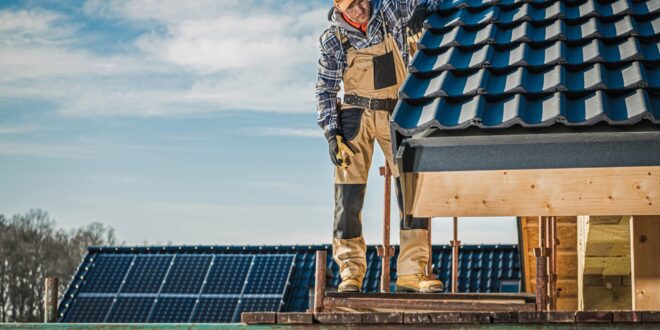Roofing contractors must deal with demanding clients and never-ending orders. Things can get hazy. If you’ve been roofing for years, it’ll start to feel natural, and that is where mistakes creep in. To succeed in the business, you must figure out how to follow standard roofing practices while keeping your customers happy.
One thing you shouldn’t neglect as a roofing contractor is building brand trust. To build trust, you must learn about operating in the market, from customer relationships to job delivery. Sound roofing advertisement ideas can help you get jobs, but ultimately, job delivery determines which customers stay.
This article will teach you how to dot the i’s and cross the t’s in your roofing business.
10 things you should never neglect as a roofing contractor
If you’re looking to set a standard of excellence in your roofing business, here’s what you should pay attention to as a roofing contractor.
1. Roofing Insurance
Many things can go wrong when you’re working on a roof. Hence, you must have contractor insurance to protect your company, employees, and customers. Roofing insurance may seem minor, but it’s vital in case of accidents and lawsuits.
Commercial property insurance covers property and equipment damage. You can add a “tools and equipment floater” to your insurance coverage to safeguard any specific tools and equipment required for your company.
Your clients will like knowing the person working on their roof is doing their due diligence when it comes to insurance, which is why it’s important to never neglect.
2. Flashing
Flashing is the metal or plastic that goes around the edges of a roof to seal and protect it from moisture. It directs water away from walls and prevents it from entering the openings on a roof. Poor flashing is the most common cause of leaks in roofs.
As a professional roofer, you’ll need to pay attention to flashing quality and arrangement when installing. Use only the right flashing size; otherwise, there will be spaces where water can seep into your client’s home.
3. Shingles installation
Manufacturers produce shingles in batches. Every batch has a unique color tone. If you buy shingles from different manufacturers, they’ll look different. The overall functionality and appearance of the roof can be reduced when low-quality or shingles of different colors are used.
It’s unprofessional to use different shingles for one roof. Your client will notice if you get shingle installation wrong.
4. Starter strips
Failure to use starter strips in roofing is a common cause of roof leakage through the cutouts of the bottom shingles. You should always place strips underneath the first course of shingles around the roof’s edge. Don’t use conventional shingles as a beginner course, or you risk getting poor reviews.
5. Roof coatings
Before you start a roofing project, consider the environment in which the building is located. You should choose a coating that matches the area’s climate so it will last and provide optimal protection.
Some coatings are not appropriate for use on metal roofs, so be sure you know what type of metal a roof is made of before buying a coating. Epoxy-based roof coatings might be harmful in areas with high humidity or rainfall. This epoxy-based covering will coil up by itself, taking the roof with it. This may result in leaks, which might eventually lead to roof failure.
6. Building codes
Building codes are designed to ensure that buildings are structurally sound, safe, and energy efficient. In addition, they protect the environment by requiring that products used in construction have been tested and certified for use by an accredited laboratory or testing facility.
Depending on the number of occupants and what the building is for, some structures must have a minimum fire resistance level. As a roofer, you must consider thermal insulation when roofing and adhere to the manufacturer’s instructions, energy standards, and code requirements, which might vary depending on the roof type.
7. Underlayment
Before you place shingles on the roof, you should apply an underlayment. It is the first protection layer for your roofing contractor and should be installed properly to ensure water does not get through.
Types of underlayment can include rubberized asphalt, felt that’s asphalt-saturated, and synthetic non-bitumen underlayment. While rubberized asphalt is waterproof, asphalt-saturated synthetic and felt underlayment are known to be water-resistant. Using roofing felt on your home provides a waterproof barrier. It helps prevent water from infiltrating the roof structure and causing damage to the underlying materials.
Non-bitumen underlayment is excellent, but you must be detailed when installing them. Wrong installation will cause moisture absorption issues.
8. Nail usage
You need to be extra careful about your nails because a lot of damage can be caused by using the wrong nails for your roofing project.
If you use nails that are too small, they will not hold the shingles properly. If you use nails that are too large, they may damage the shingle mat. Also, the nails will tear through and come loose if the nail gun is firing too deeply, nearly breaking through the shingles.
To avoid this, lower the settings for the air compressor and the gun depth. Also, pay attention to the angle when nailing.
9. Roof slope
The sloped surface of a roof helps water run off it. The steeper the roof pitch, the more quickly rainwater will run off and away from your home. When installing asphalt and wood roofing systems, use 4 units rise per 12 units of run.
10. Roofing ventilation
Condensation forms on the roof deck as moisture rises with the hot air without appropriate ventilation. The water on the roof deck starts to damage the wood as soon as it occurs. Don’t neglect ventilation. Always check if any of the vents are covered by insulation. Install ridge vents along the length of the roof if you have to.
Final takeaways
Remember that your customers will trust you with their commercial or residential properties. Keeping the structures safe from the elements is essential, so never compromise that. Also, ensuring that your prospective customers are educated on the importance of roofing maintenance will lead to their future referrals and repeat business.
 HammBurg Be informed with latest news, reviews, entertainment, lifestyle tips, and much more.
HammBurg Be informed with latest news, reviews, entertainment, lifestyle tips, and much more.




